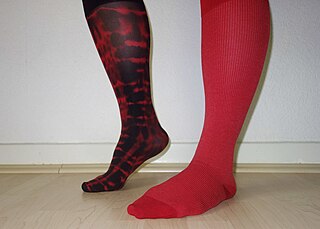Related Research Articles

Massage is the manipulation of the body's soft tissues. Massage techniques are commonly applied with hands, fingers, elbows, knees, forearms, feet, or a device. The purpose of massage is generally for the treatment of body stress or pain. A person professionally trained to give massages is traditionally known as a masseur (male) or a masseuse (female) in European countries. In the United States, these individuals are often referred to as massage therapists because they must be certified and licensed as "Licensed Massage Therapists".

Angina, also known as angina pectoris, is chest pain or pressure, usually due to insufficient blood flow to the heart muscle.

Priapism is a condition in which a penis remains erect for hours in the absence of stimulation or after stimulation has ended. There are three types: ischemic (low-flow), nonischemic (high-flow), and recurrent ischemic (intermittent). Most cases are ischemic. Ischemic priapism is generally painful while nonischemic priapism is not. In ischemic priapism, most of the penis is hard; however, the glans penis is not. In nonischemic priapism, the entire penis is only somewhat hard. Very rarely, clitoral priapism occurs in women.

Compartment syndrome is a condition in which increased pressure within one of the body's anatomical compartments results in insufficient blood supply to tissue within that space. There are two main types: acute and chronic. Compartments of the leg or arm are most commonly involved.

Cerebral edema is excess accumulation of fluid (edema) in the intracellular or extracellular spaces of the brain. This typically causes impaired nerve function, increased pressure within the skull, and can eventually lead to direct compression of brain tissue and blood vessels. Symptoms vary based on the location and extent of edema and generally include headaches, nausea, vomiting, seizures, drowsiness, visual disturbances, dizziness, and in severe cases, coma and death.

Ischemia or ischaemia is a restriction in blood supply to tissues, causing a shortage of oxygen that is needed for cellular metabolism. Ischemia is generally caused by problems with blood vessels, with resultant damage to or dysfunction of tissue. It also means local anemia in a given part of a body sometimes resulting from constriction. Ischemia comprises not only insufficiency of oxygen, but also reduced availability of nutrients and inadequate removal of metabolic wastes. Ischemia can be partial or total.

Reflex syncope is a brief loss of consciousness due to a neurologically induced drop in blood pressure. Before an affected person passes out, there may be sweating, a decreased ability to see, or ringing in the ears. Occasionally, the person may twitch while unconscious. Complications of reflex syncope include injury due to a fall.
Manual therapy, or manipulative therapy, is a physical treatment primarily used by physical therapists, physiotherapists, occupational therapists to treat musculoskeletal pain and disability; it mostly includes kneading and manipulation of muscles, joint mobilization and joint manipulation. It's also used by Rolfers®, massage therapists, athletic trainers, osteopaths, and physicians
Myofascial trigger points, also known as trigger points, are described as hyperirritable spots in the skeletal muscle. They are associated with palpable nodules in taut bands of muscle fibers. They are a topic of ongoing controversy, as there is limited data to inform a scientific understanding of the phenomenon. Accordingly, a formal acceptance of myofascial "knots" as an identifiable source of pain is more common among bodyworkers, physical therapists, chiropractors, and osteopathic practitioners. Nonetheless, the concept of trigger points provides a framework which may be used to help address certain musculoskeletal pain.
Anterior ischemic optic neuropathy (AION) is a medical condition involving loss of vision caused by damage to the optic nerve as a result of insufficient blood supply (ischemia). This form of ischemic optic neuropathy is generally categorized as two types: arteritic AION, in which the loss of vision is the result of an inflammatory disease of arteries in the head called temporal arteritis, and non-arteritic AION, which is due to non-inflammatory disease of small blood vessels.
Posterior ischemic optic neuropathy (PION) is a medical condition characterized by damage to the retrobulbar portion of the optic nerve due to inadequate blood flow (ischemia) to the optic nerve. Despite the term posterior, this form of damage to the eye's optic nerve due to poor blood flow also includes cases where the cause of inadequate blood flow to the nerve is anterior, as the condition describes a particular mechanism of visual loss as much as the location of damage in the optic nerve. In contrast, anterior ischemic optic neuropathy (AION) is distinguished from PION by the fact that AION occurs spontaneously and on one side in affected individuals with predisposing anatomic or cardiovascular risk factors.

Venous ulcers are wounds that are thought to occur due to improper functioning of venous valves, usually of the legs. They are the major occurrence of chronic wounds, occurring in 70% to 90% of leg ulcer cases. Venous ulcers develop mostly along the medial distal leg, and can be painful with negative effects on quality of life.

Compression stockings are a specialized hosiery designed to help prevent the occurrence of, and guard against further progression of, venous disorders such as edema, phlebitis and thrombosis. Compression stockings are elastic compression garments worn around the leg, compressing the limb. This reduces the diameter of distended veins and increases venous blood flow velocity and valve effectiveness. Compression therapy helps decrease venous pressure, prevents venous stasis and impairments of venous walls, and relieves heavy and aching legs.
Cold compression therapy, also known as hilotherapy, combines two of the principles of rest, ice, compression, elevation to reduce pain and swelling from a sports or activity injury to soft tissues and recommended by orthopedic surgeons following surgery. The therapy is especially useful for sprains, strains, pulled muscles and pulled ligaments.
Cerebral vasculitis is vasculitis involving the brain and occasionally the spinal cord. It affects all of the vessels: very small blood vessels (capillaries), medium-size blood vessels, or large blood vessels. If blood flow in a vessel with vasculitis is reduced or stopped, the parts of the body that receive blood from that vessel begins to die. It may produce a wide range of neurological symptoms, such as headache, skin rashes, feeling very tired, joint pains, difficulty moving or coordinating part of the body, changes in sensation, and alterations in perception, thought or behavior, as well as the phenomena of a mass lesion in the brain leading to coma and herniation. Some of its signs and symptoms may resemble multiple sclerosis. 10% have associated bleeding in the brain.
Blood-injection-injury (BII) type phobia is a type of specific phobia characterized by the display of excessive, irrational fear in response to the sight of blood, injury, or injection, or in anticipation of an injection, injury, or exposure to blood. Blood-like stimuli may also cause a reaction. This is a common phobia with an estimated 3-4% prevalence in the general population, though it has been found to occur more often in younger and less educated groups.

A placental disease is any disease, disorder, or pathology of the placenta.

Nerve compression syndrome or compression neuropathy, is a medical condition caused by direct pressure on a nerve. It is known colloquially as a trapped nerve, though this may also refer to nerve root compression. Its symptoms include pain, tingling, numbness and muscle weakness. The symptoms affect just one particular part of the body, depending on which nerve is affected. Nerve conduction studies help to confirm the diagnosis. In some cases, surgery may help to relieve the pressure on the nerve but this does not always relieve all the symptoms. Nerve injury by a single episode of physical trauma is in one sense a compression neuropathy but is not usually included under this heading.
Chronic limb threatening ischemia (CLTI), also known as critical limb ischemia (CLI), is an advanced stage of peripheral artery disease (PAD). It is defined as ischemic rest pain, arterial insufficiency ulcers, and gangrene. The latter two conditions are jointly referred to as tissue loss, reflecting the development of surface damage to the limb tissue due to the most severe stage of ischemia. Compared to the other manifestation of PAD, intermittent claudication, CLI has a negative prognosis within a year after the initial diagnosis, with 1-year amputation rates of approximately 12% and mortality of 50% at 5 years and 70% at 10 years.
Ischemia-reperfusion (IR) tissue injury is the resultant pathology from a combination of factors, including tissue hypoxia, followed by tissue damage associated with re-oxygenation. IR injury contributes to disease and mortality in a variety of pathologies, including myocardial infarction, ischemic stroke, acute kidney injury, trauma, circulatory arrest, sickle cell disease and sleep apnea. Whether resulting from traumatic vessel disruption, tourniquet application, or shock, the extremity is exposed to an enormous flux in vascular perfusion during a critical period of tissue repair and regeneration. The contribution of this ischemia and subsequent reperfusion on post-traumatic musculoskeletal tissues is unknown; however, it is likely that similar to cardiac and kidney tissue, IR significantly contributes to tissue fibrosis.
References
- ↑ Montanez-Aguilera FJ; Valtuena-Gimeno N; Pecos-Martin D; Arnau-Masanet R; Barrios-Pitarque C; Bosch-Morell F (2010). Changes in a patient with neck pain after application of ischemic compression as a trigger point therapy. Journal of Back & Musculoskeletal Rehabilitation, 23(2), 101–104. doi : 10.3233/BMR-2010-0255